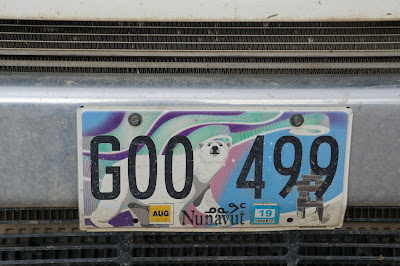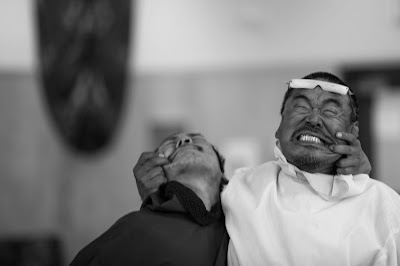Storm clouds added a drama to the towering cliffs.
Icebergs were a near constant.
As were the glaciers creating them.
This was not a morning for breakfast on the aft deck.
About 3pm we made it to Mittimatalik (Pond Inlet), the capital of Nunavuk, Canada.
Pond Inlet was named in 1818 by John Ross for John Pond an English astronomer. Mittimatslik in the local language Inukitut means "the place where Mitima is buried". Pond Inlet is a small, predominately Inuit, community in the Qikiqtaaluk Region of Nunavut, Canada. It is located at the top of Baffin Island and has a population of 1,600. Mittimatslik is the largest town above the 72nd parallel and is ice free for about 3 1/2 months a year. The town's economy is largely service-based with government as the largest employer.
The Inukitut language (understood throughout the arctic Siberia to Greenland) is quite different from Greenlandish (which has a heavy Danish influence). The script is unlike any I have ever seen. According to Wikipedia:Inuktitut syllabics ᑎᑎᕋᐅᓯᖅ ᓄᑖᖅ [titiʁauˈsiq nuˈtaːq]) is an abugida-type writing system used in Canada by the Inuktitut-speaking Inuit of the territory of Nunavut and the Nunavik region in Quebec. In 1976, the Language Commission of the Inuit Cultural Institute made it the co-official script for the Inuit languages, along with the Latin script.
Mittimatalik is a very poor hamlet compared to Sisimiut, Greenland. Since supplies from the outside are difficult and expensive to transport, everything of possible future use is left outside in yards for repurposing. The communal dog yard is in the center of town.
Once again we anchored out and zodiaced to shore. Local guides lead us in small groups about town.
A traditional Thule sealskin covered, sod house.
Mittimalik has a small museum.
I love these dog booties.
Seal hunting sled.
I have a small collection of Canadian and Alaskan license plates. I asked our guide about getting one of these. He was quite proud of them and indicated that they are new. He seriously doubted that there would be any lying around.
Our guide had lived in Mittimatalik all of his life and was a wealth of knowledge about hunting - (each hunter has a limit and all animals killed are registered at the communal office and disbursed throughout the community); subsistence living - (hunters can keep what they kill if their family is in need but, kills are still registered); and the historical displacement of the Inuit (tragic tales of historical moving of native peoples such as went on in America). He told of one inland group from near the tree line that was forcibly moved north to Ellesmere Island. They knew nothing about ocean hunting and were not prepared with clothing, housing or weapons. He said the he, his father and other people from Mittimatalik traveled north on dogsled to help them survive the first year. The settlement is now abandoned.
Part of our tour included a show put on by a local theater group.
The show started with an elder woman and male. She lit and kept the soapstone oil lamp flame going by feeding it strands of moss and sang while he danced with his drum. He gave a very moving oration about life of his elders, his life and the future of his children "they will have it easier but will it be better?" Then came the younger women, men and children aged down to two babies nestled in their mother's amautiks - special hoods on a woman's anorak parka where a baby rides until about the age of 2.
The games, the drumming, the dances, I was transported to Nome.
Or the twirling of ptarmigan feet on a string? Or the mouth pulling where two contestants wrap their arm around the other's neck and use their forefingers to pull at the side of the mouth of their opponent?
Or the seal dance where contestants race across the floor with a swimmer's butterfly motion without ever touching anything but their toes and elbows to the ground (basically a moving "plank position" on steroids). Or the high kick? All of the Inuit games and dances are meant for entertainment in small, crowded dwellings. The songs and drumming tell stories and pass on lore.
(Credit for the B&W photos go to Ryder, aNat Geo photographer. Our group was told we could not take pictures during the preformance.)
Back to the ship for another night of northward travel.
Sunset was at 2145.



























.jpg)




